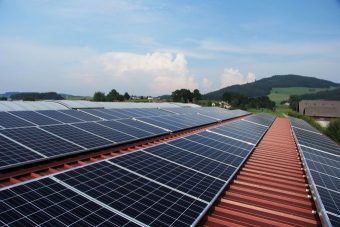
A series of economic ‘tipping points’ could lead to a surge in renewables deployment in the UK and Germany over the next decade, paving the way for the countries to rely entirely on renewable power for lengthy periods from as early as 2030.
That is the conclusion of a new report from Bloomberg New Energy Finance released today on the sidelines of the COP23 Climate Summit and commissioned by energy storage specialist Eaton and the Renewable Energy Association.
Entitled Beyond the Tipping Point, the study explores how the power grid is likely to respond to a huge increase in the use of variable renewables technologies, such as wind and solar farms. It argues that inflexible ‘baseload’ technologies such as nuclear and coal plants will face a “very challenging environment” as renewables and energy storage costs plummet and new flexible grid management technologies are deployed.
Specifically, the report predicts renewables will account for more than half of UK and German power supplies by 2026, rising to 63 per cent by 2040.
It adds that this surge in renewables deployment will mean that from 2030 there could be whole weeks where wind and solar generation exceed demand at some point each day, while from 2040 wind and solar could generate enough power to meet weekly demand during some weeks, paving the way for energy storage technologies to enable a fully renewables-powered grid.
“In this environment, flexible power technologies such as energy storage and gas generators will have an advantage,” the report states. “In addition, certain types of demand response such as flexible electric vehicle charging and variable industrial loads can respond quickly to conditions on the grid, or shift or consume surplus renewable energy.”
The report acknowledges that a big increase in renewables capacity will require some wind and solar farms to be curtailed when supply exceeds demand. But it argues new flexible grid technologies should mean curtailment does not climb to significant levels. The report calculates that by 2030 less than one per cent of UK and three per cent of German wind and solar generation will be ‘wasted’ due to oversupply.
“This study highlights a seismic shift in how power systems will operate in future,” said Albert Cheung, head of global analysis at Bloomberg New Energy Finance. “As wind and solar become the cheapest options for power generation, the race is on to develop and deploy the flexible resources that will complement them.”
Louis Shaffer, distributed energy segment manager for Europe, Middle East and Africa at Eaton, said the report would be followed a second study early next year that will explore how new technologies and policies can help deliver more flexible grids in support of renewables deployment. “These solutions could include continued promotion of smart metering, reforms to increase market openness and transparency for all grid ancillary services and long-term grid service contracts and pricing schemes,” he explained.
Dr Nina Skorupska, chief executive of the Renewable Energy Association, said the report provided further evidence that “wind and solar power are now the cheapest form of new build generation in many cases, and costs will continue to fall dramatically”.
“Massive increases in future renewable power generation mean that industry and government must start planning now to ensure low-carbon, cost-effective ways of balancing demand and supply,” she said. “We believe that there is a role for fuelled renewable technologies such as bioenergy and energy from waste to provide the complementary baseload generation that will be required, to avoid the need for carbon intensive generation at all. This study shows that battery storage is well placed to serve short term supply and demand issues and highlights the dramatic cost reductions in renewable power over the past few years.”
The report follows a study last week from German non-profit Energy Watch Group and the Lappeenranta University of Technology in Finland, which argued that a 100 per cent renewable powered grid was both technically and economically feasible.
It also comes on the same day as the International Energy Agency published its annual World Energy Outlook report, which predicts a seismic shift in the global energy market through to 2040, with China taking the lead on renewables and nuclear generation over the next three decades as the US becomes a leader in oil and gas exports.
Although the paper predicts a dramatic rise in the use of wind, solar and natural gas between now and 2040, as well as the end of the “boom years” for coal consumption, it stresses that decarbonisation efforts will not move nearly fast enough to avoid severe climate change without a major new investment and policy push.
Source: businessgreen.com

